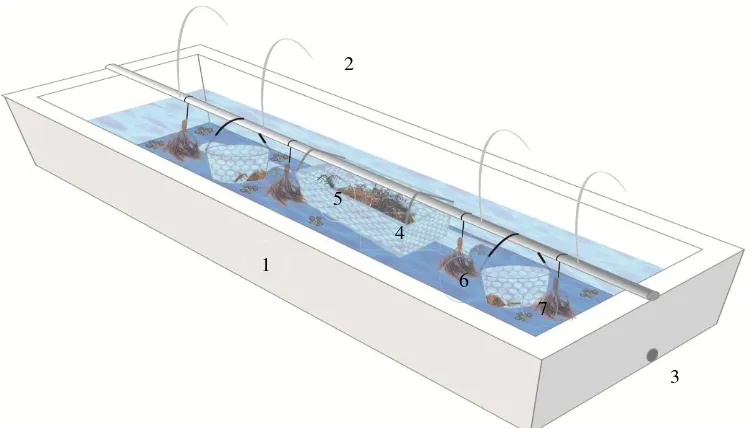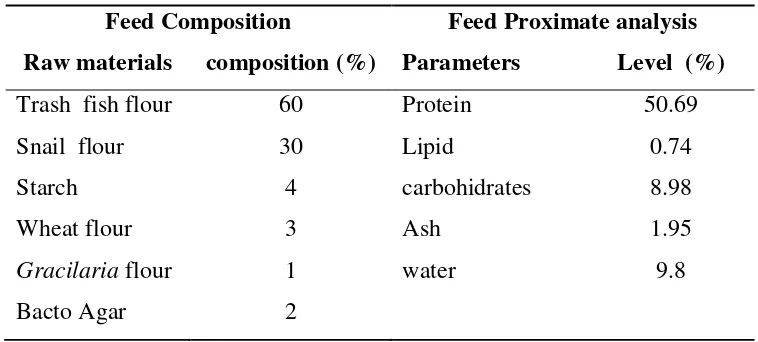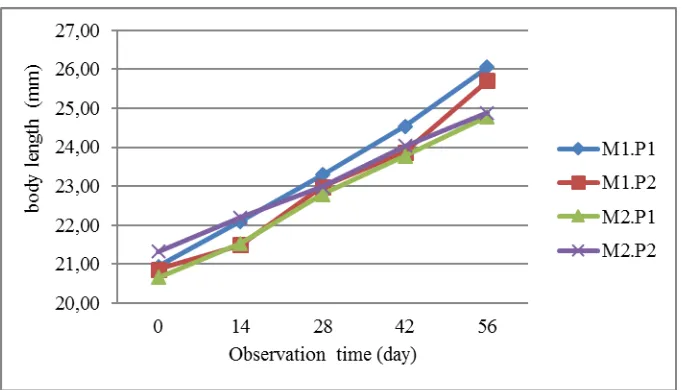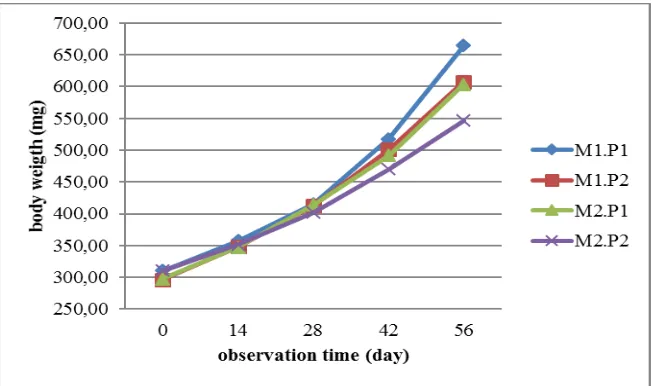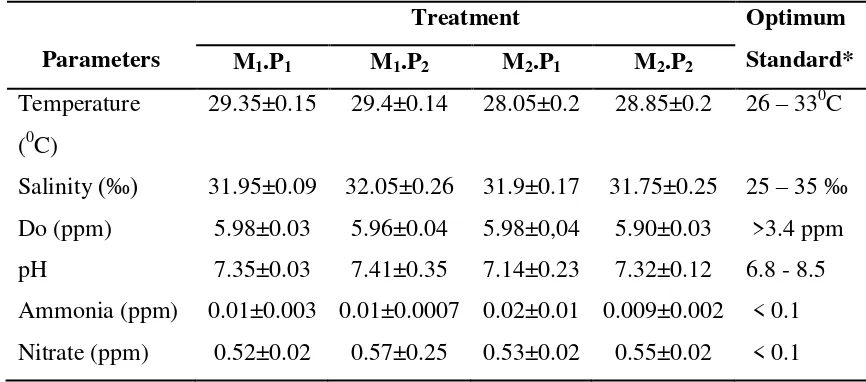A Monthly Double-Blind Peer Reviewed Refereed Open Access International e-Journal - Included in the International Serial Directories.
International Research Journal of Natural and Applied Sciences (IRJNAS) ISSN: (2349-4077) 55 | P a g e International Research Journal of Natural and Applied Sciences Vol. 3, Issue 8, August 2016 IF- 3.827 ISSN: (2349-4077)
© Associated Asia Research Foundation (AARF)
Website: www.aarf.asiaEmail : editor@aarf.asia , editoraarf@gmail.com
GROWTH OF SPINY LOBSTER (
Panulirus homarus
)
IN THE
INTEGRATED MULTI TROPIC AQUACULTURE
SYSTEM
Mita Ayu Liliyanti1, Muhammad Ali1 & Faturrahman2
1
Animal Husbandry Faculty Mataram University,
2
Department of Biology, Faculty of Mathematics and Natural Sciences, Mataram University, Jl. Majapahit 62, Mataram 83125, West Nusa Tenggara, Indonesia.
ABSTRACT
The implementation of Integrated Multi Tropic Aquaculture (IMTA) has several advantages
compared with cultivating monocultures. The purpose of this study was to evaluate the growth of
lobster sand on IMTA system. Lobster growth performance and environmental quality in an
IMTA system fed naturally evaluated and compared with a lobster on monocultures fed local
natural and artificial feed. The results showed that the growth of lobster at IMTA system better,
although not significantly different (P <0.05) when compared with the growth of lobster on
monocultures, both fed with natural or artificial feed. Similarly, the presence of abalone as
companion animals do not affect to lobster growth and to the quality of water in aquaculture
pond.
KEYWORDS: IMTA, LOBSTER, PANULIRUS, MONOCULTURE, ARTIFICIAL FEED
INTRODUCTION
Spiny lobster is one commodity that is now demanding public both domestically and
abroad. The number of lobster catch increased to 40 778 MT in the period of 6 years. It is
related to the amount of lobster demand continues to increase every year. Meanwhile, the fulfillment of the demand is still relying on the arrest in nature 1. This situation may lead to a
decrease in the amount of lobster populations. So the lobster aquaculture needs to be done in
A Monthly Double-Blind Peer Reviewed Refereed Open Access International e-Journal - Included in the International Serial Directories.
International Research Journal of Natural and Applied Sciences (IRJNAS) ISSN: (2349-4077) 56 | P a g e In Indonesia particularly in West Nusa Tenggara region is a region with a number of
arrests of seed lobsters are quite high and continues to increase every year. However, this is not
accompanied by cultivation. This is because the development of the cultivation of sea lobsters
are often faced with the length of time of maintenance and the availability of natural feed
fluctuating.
For the cultivation of the IMTA system (Integrated Multi-Tropic Aquaculture) is one
alternative that can be applied in the cultivation of lobster that with this system maintenance can
be done with two or three commodities. The IMTA (Integrated Multi-Tropic Aquaculture) is a
system of aquaculture that integrate multiple organisms tropics in a system of interconnected and
integrated in order to increase the benefit through interaction between the tropics in a farming,
for example between seaweed with animals consuming seaweed 2 .
the adoption of IMTA using three different commodities tropics in one area of
cultivation will be able to multiply revenues and at the same time as a form of anticipation of the
possibility of crop failure or decline in productivity on one commodity. The application of this
system of cultivation is also an effort to support the government's policy on the concept of blue
economy to create environmentally friendly aquaculture and sustainable and can increase the productivity of the production 3, 4.
So far research on lobster growth in juvenille stadia are maintained along with two other
commodities have not been reported. It is necessary for research on lobster farming with IMTA
system. Choice of lobster companion organisms used are abalone (Haliotis asinina) and seaweed
(Gracilaria sp).
1. MATERIALS DAN METHODS
1.1. Preparation of Organism Test
IMTA test animals in this study using a seed of spiny lobster (Panulirus homarus) with
an average length of 20.94 ± 0.13 mm and a weight of 303.81 mg ± 3.39; abalone (Haliotis
asinina) with an average weight of 4448 ± 239 mg obtained from Hatcheries and Production of
Abalone Unit, Marine Aquaculture Research Center; and seaweed (Gracilaria sp.) obtained
from the cultivation of fishermen in the bay Gerupuk. Lobster seed selected brightly colored
A Monthly Double-Blind Peer Reviewed Refereed Open Access International e-Journal - Included in the International Serial Directories.
International Research Journal of Natural and Applied Sciences (IRJNAS) ISSN: (2349-4077) 57 | P a g e pools and looks fresh. Abalone seed brightly colored, can be attached hard on the substrate.
While Gracilaria sp selected seeds are highly branched, spired, leafy and brightly colored.
The procedure of preparation of test animals as follows: abalone and lobster maintained
at 26-28°C in a polyethylene tank containing 98 L of seawater filtered and aerated continuous
basis. Acclimatized for 2 weeks abalone and lobster for 3 days before being used for research,
during this process abalone only fed with fresh Gracilaria and lobster fed artificial feed.
1.2. Preparation Container Maintenance
16 units of fiber tub-shaped beam to the size (3x1x0,6) m3 volume of 1.5 m3 was used as
aquaculture pond. This tub is equipped with inlet and outlet channels as well as 4 point aeration.
Lobster container is a rectangular form in size (40x30x30) cm3 and two baskets circular with a
diameter of 35 cm and 20 cm high. So that in each tub is placed 3 baskets with hanging position
on the inlet pipe mounted horizontally above the tub. As for the cultivation of seaweed done
verticulture and also off in baskets maintenance lobster. Furthermore, pvc pipe laid halved as a
place of attachment and hiding lobster and abalone. For more details on the maintenance
container designs like Figure 1 below.
Figure 1. Design Container Maintenance of the System IMTA (1: pond aquaculture, 2:
inlet, 3: outlet, 4: lobster, 5: lobster, 6: seaweed, 7: abalone).
7 1
2 1
3 5
A Monthly Double-Blind Peer Reviewed Refereed Open Access International e-Journal - Included in the International Serial Directories.
International Research Journal of Natural and Applied Sciences (IRJNAS) ISSN: (2349-4077) 58 | P a g e 1.3. Feed preparation
Fresh trash fish of species Sardinella sp. is used as a natural food. For artificial feed used
local materials consisting of trash fish flour, snail flour, and flour gracilaria. All these ingredients
are mixed until homogeneous, added starch, wheat flour, and bacto agar, then stirred again until
homogenous. Given a little water, stirring to form a dough. Furthermore, steamed dough for ± 15
minutes. Once cool, the dough is ready printed form of feed pellets. The proximate composition
and test results of these locally made feed in Table 1.
Table 1. Feed Composition and Proximate analysis results of the Local Feed.
Feed Composition Feed Proximate analysis
Raw materials composition (%) Parameters Level (%)
Trash fish flour 60 Protein 50.69
Snail flour 30 Lipid 0.74
Starch 4 carbohidrates 8.98
Wheat flour 3 Ash 1.95
Gracilaria flour 1 water 9.8
Bacto Agar 2
2.4. Lobster Growth Test.
Prior to the experiment performed all equipment disinfected with a solution of 50-100
ppm chlorine. Furthermore, as many as 16 tubs used as a container maintenance and seawater
flowed at a constant rate of 1000 ml / min. Sixteenth container maintenance is divided into four
treatment combinations, namely M1.P1 (IMTA with natural feeding); M1.P2 (IMTA with
artificial feeding); M2.P1 (Monoculture with natural feeding); and M2.P2 (monoculture with
artificial feeding). Each treatment consisted of 4 tub containing 20 lobster and 30 abalone.
To maintain the quality of water, the aquarium is cleaned every 2 days by sucking
unconsumed feed and faeces lobster and abalone. Lobster fed as much as 30% of body weight
every day in the morning and afternoon. Faeces and feed residue is weighed, while the body
A Monthly Double-Blind Peer Reviewed Refereed Open Access International e-Journal - Included in the International Serial Directories.
International Research Journal of Natural and Applied Sciences (IRJNAS) ISSN: (2349-4077) 59 | P a g e 2.5. Data analysis
Variable growth of juvenile lobster observed included a weighted average initial and final
(g), and feed intake (g). Based on these data calculated biomass growth (g), the relative growth
(%), feed efficiency (%) and feed conversion.
RESULT AND DISCUSSION
Lobster Growth Patterns
Length and weight growth pattern of lobster cultivated in IMTA and monocultures
systems fed with natural and artificial feed for 56 days of observation are presented in Figure 2
and 3
Figure 2. Length growth pattern of lobster. M1.P1 (IMTA with natural feeding); M1.P2 (IMTA
with artificial feeding); M2.P1 (Monoculture with natural feeding); and M2.P2
(monoculture with artificial feeding).
Figure 2 above shows that an increase in the length lobster during the study period in
each treatment. At M1.P1 treatment which is a combination treatment of IMTA systems with
natural feeding showed the highest growth in the long end of the study. Whereas, in the treatment
M2.P1 which is a combination of treatment between monoculture system with natural feeding
A Monthly Double-Blind Peer Reviewed Refereed Open Access International e-Journal - Included in the International Serial Directories.
International Research Journal of Natural and Applied Sciences (IRJNAS) ISSN: (2349-4077) 60 | P a g e IMTA systems with artificial or natural feeding showed the average length growth better than
monocultures. While the growth pattern of body weight are presented in Figure 3 below.
Figure 3. Weigth growth pattern of lobster. M1.P1 (IMTA with natural feeding); M1.P2 (IMTA
with artificial feeding); M2.P1 (Monoculture with natural feeding); and M2.P2
(monoculture with artificial feeding).
Figure 3 shows that the growth of the weight on all treatments at day 14 to day 28
showed growth was not different. from day to 42 growth began to vary and on day 56 of
treatment showed a growth pattern M1.P1 highest weight. pattern of growth shown by the lowest
weight combined treatment monoculture system with artificial feeding (M2.P2). Results lowest
weight gain is not the same as the results of the lowest partumbuhan body length, this indicates
that the relationship is not balanced growth of body weight with a body length. Growth
unbalanced body length and weight growth is not as fast as described 5 as the allometric
growth.
Lobster Growth Rate
Lobster growth parameters treated with IMTA and monoculture system for 56 days
maintenance includes biomass growth (g), relative growth (%), feed efficiency (%) and feed
A Monthly Double-Blind Peer Reviewed Refereed Open Access International e-Journal - Included in the International Serial Directories.
International Research Journal of Natural and Applied Sciences (IRJNAS) ISSN: (2349-4077) 61 | P a g e Table 2. Growth in biomass, growth in length and relative growth of spiny lobster
for 56 days of maintenance.
Note: M1.P1 (IMTA with natural feeding); M1.P2 (IMTA with artificial feeding); M2.P1
(Monoculture with natural feeding); and M2.P2 (monoculture with artificial feeding). The same
letter indicates no difference between treatments (P<0.05).
The table 2 shows that the weight of the highest growth achieved by treatment with
feeding natural IMTA (M1.P1) with a growth rate of 6.32 mg / day. While the lowest weight
gain was obtained from the combined treatment with artificial feed monoculture (M2.P2) with a
value of 4.21 mg/day. Lobster long growth also showed the best value in the treatment of IMTA
combined natural feed (M1.P1) with growth of 5.12 ± 0.39 mm/56 days and the lowest rate with
treatment (M2.P2) is a combination treatment of monocultures with artificial feed with growth
3.57 ± 0.26 mm/ 56 days. But the results of the analysis showed that the treatment was not
explained by the growth of the length of the lobster itself. In this study, body weight growth was
faster than the length of the body. This is contrary to the statement 6 which states that growth
A Monthly Double-Blind Peer Reviewed Refereed Open Access International e-Journal - Included in the International Serial Directories.
International Research Journal of Natural and Applied Sciences (IRJNAS) ISSN: (2349-4077) 62 | P a g e GENSTAT edition 4 on weight and body length obtained results were not significantly different
(p <0.05) in the treatment of cultivation systems and types of feed.
Although statistical analysis showed no significantly different results, but treatment
with IMTA systems showed better growth rate than monokulture system. IMTA is a system that
combines the cultivation of marine plants with an aquatic animal potentially reduce costs,
improve efficiency and productivity of a number of species 7, 8. In this study kelp seaweed
used is of the type Gracilaria sp. Selection was based on the statement of Gracilaria sp 9 that
the selection of commodities in aquaculture IMTA system should pay attention to various
aspects, including the selected species is a different species of tropical and can grow well so that
they can act as an effective biofilter. According 10 also expressed high production of shrimp
that are kept together with seaweed Gracilaria sp. due to the presence Gracilaria sp. can create
conditions better environment that can act as a biofilter can reduce levels of Fe2+ and BOT that can slow the growth of bacteria and disease. This statement in accordance with 11 that the high
waters BOT is closely connected with the population of bacteria and the application of seaweed
can absorb the excess of various nutrients. A few species of red algae have been found to have a
high enough ability to adsorb metal ions, either alive or dead cells form or biomass 12.
Furtermore 10 reiterated that the seaweed play a role in inhibiting the movement of water so
that soluble materials sink to the bottom.
Accordingly, this study also showed that treatment with IMTA system providing heavy
growth lobster better than the monokulture system. In addition due to the existence of seaweed
acts as biofolter in container cultivation that can maintain the quality of the water during the
study. Seaweed is also known to be useful as a shelter or a shelter when moulting and hide
during the day. That the seaweed (algae) is the second food choice of lobster, so the existence of
Gracilaria sp. can be used as a natural food that could nourish the growth of lobster 13. That
the seaweed from the red algae are potential sources as feed additives because it can increase the
protein digestability 14. Gracilaria sp. in Indonesia has a composition of 4.17% protein,
carbohydrates 42.59% and 9.54% fat, crude fiber 10.51%, ash 14.18% and 19.01% water content 15.
Similar results were obtained from analysis of the effect of natural food and artificial
feed in this study was also no significant effect on each treatment. This is due, based on the
A Monthly Double-Blind Peer Reviewed Refereed Open Access International e-Journal - Included in the International Serial Directories.
International Research Journal of Natural and Applied Sciences (IRJNAS) ISSN: (2349-4077) 63 | P a g e much different. Proximate analysis results can be seen in Table 3. Although the results of the
analysis showed that the content is not much different, but at the natural food treatment showed
high growth in each basin. The influence of the growth in aquaculture is the feed consumption
that leads to the value of feed efficiency and feed conversion. The value of feed and feed
conversion efficiency in these observations are presented in Table 3 below.
Table 3. Average of feed efficiency and feed conversion during the 56-day maintenance of
lobster
Treatment Feed Consume (mg) Feed Efficiency Feed conversion
M1.P1 65.753.25±2099.77 17.61 5.70
M1.P2 62.944.00±2163.82 18.35 5.52
M2.P1 44.395.50±4260.11 43.22 2.74
M2.P2 40.447.63±2155.00 52.06 3.04
M1.P1 (IMTA with natural feeding); M1.P2 (IMTA with artificial feeding); M2.P1
(Monoculture with natural feeding); and M2.P2 (monoculture with artificial feeding).
These results indicate that the average consumption of lower value obtained from treatment
of artificial feed on natural food appeal. This is in line with the lower growth results obtained in
the treatment given artificial feed. From these results it can be said that the growth rate is
proportional to feed consumption. Other reseacher 16 shown the growth and survival of the
lobster that consuming artificial feed known to be lower than the lobster that consume natural
feed, although feed Artificial easy consumption. According 17 that the appeal of artificial feed
for a shorter lobster consumed only reached 1-2 hours compared with natural food that reaches
10 hours or more. This is the possibility that the cause of natural food is still the main choice in
the maintenance of lobster until today. However, 18 states that the use of natural feed
ineffective and impractical for large-scale cultivation in the cultivation of lobster. So from the
use of artificial feed overall productivity continues to develop lobster farming lobster for success
in the future.
In addition to the factors mentioned above, the water quality in the basin maintenance is
also greatly affect the productivity of cultivated organisms. As for the quality of water in the
A Monthly Double-Blind Peer Reviewed Refereed Open Access International e-Journal - Included in the International Serial Directories.
International Research Journal of Natural and Applied Sciences (IRJNAS) ISSN: (2349-4077) 64 | P a g e Table 4. Results of the analysis of water quality in each treatment for 56 days of maintenance
Parameters
Treatment Optimum
Standard* M1.P1 M1.P2 M2.P1 M2.P2
Temperature
(0C)
29.35±0.15 29.4±0.14 28.05±0.2 28.85±0.2 26 – 330C
Salinity (‰) 31.95±0.09 32.05±0.26 31.9±0.17 31.75±0.25 25 –35 ‰
Do (ppm) 5.98±0.03 5.96±0.04 5.98±0,04 5.90±0.03 >3.4 ppm
pH 7.35±0.03 7.41±0.35 7.14±0.23 7.32±0.12 6.8 - 8.5
Ammonia (ppm) 0.01±0.003 0.01±0.0007 0.02±0.01 0.009±0.002 < 0.1
Nitrate (ppm) 0.52±0.02 0.57±0.25 0.53±0.02 0.55±0.02 < 0.1
*Source : Vijayakumaran et al.,2010
Lobster, abalone and seaweed are sea water biota that has the potential to be developed.
Therefore, in order to increase the growth of the commodity is water quality parameters is a
supporting factor that is very influential on. Some parameters that affect the growth of marine
biota water is light, temperature, salinity, and water movement.
Based on observations of temperature, DO, salinity, pH and ammonia were observed
during the study showed the value of which is still within the threshold for the cultivation of
lobster 19. However, the observation of Nitrate shows unfavorable values ranged 0:52 ppm.
The same thing that the nitrate content of <0.1 ppm is a good range for growth of lobster
20,21.
That the range of environmental conditions suitable for maintaining abalone in the bath
is a temperature between 26 – 30oC, salinity between 32-35 ppt, DO between 4.6 - 7.1ppm and pH between 7.5 to 8.7 22. The growth of seaweed that both types Gracilria sp require water
conditions with temperatures ranging from 5 - 30oC, salinity 15-35 ppt, pH 6 – 9 23. However,
for according 24 the range of nitrate eligible to seaweed growth is 0.9 - 3.5 mg / l, this value
A Monthly Double-Blind Peer Reviewed Refereed Open Access International e-Journal - Included in the International Serial Directories.
International Research Journal of Natural and Applied Sciences (IRJNAS) ISSN: (2349-4077) 65 | P a g e CONCLUSION
Growth Rate of lobster (Panulirus homarus) are maintained by the system IMTA is
generally higher (6.32 mg/day with a natural feed, and 5.56 mg/day with the provision of
artificial feed) when compared with the monokulture system (5.46 mg/day with a natural feed,
and 4.21 mg/day with artificial feed), although not statistically significantly different (p <0.05).
The additional metabolic waste of companion animals, do not add to the ecological burden to the
aquatic environment with the presence of seaweeds as a biofilter in the IMTA systems.
REFERENCES
1. FAO, World fisheries production : estimated value by groups of species. FAO fisheries and
Aquaculture report, 2007.
2. Butterworht A., 2009. Integrated Multi Tropic Aquaculture System Incorporated Abalone
and Seaweedd. Nuffield, Australia
3. Faturrahman, I.S. Rohyani, Sukiman and H. Ahyadi. 2015. Boosted seaweed farmer income
through application of Multi Tropic Sea Farming. Proceding. International seminar on
tropical natural resources. June 2015. Mataram Indonesia
4. Faturrahman, I.S. Rohyani, Sukiman and H. Ahyadi. 2013. Optimization strategy of abalon
cultivation method as a main commodities marine fisheries. Proceding. Seminar Nasional:
Research and Sains education. Mataram Indonesia
5. Effendie, M.I. 1992. Aquatic biology method. Agromedia Foundatio, Bogor.
6. Junaidi, M., Hamzah, M.S., 2010. Water quality and its impact of growth and survival rate
of lobster were kept in floating net in Ekas bay West Nusa Tenggara Province. J. Sci. and
Technol. Trop. Ocean. 6, 2 (345-354).
7. Neori, A., Chopin, T., Troell, M., Buschmann, A.H., Kraemer, G.P., Halling, C., Shpigel,
M.,Yarish, C., 2004. Integrated aquaculture: rationale, evolution and state of the
artemphasizing seaweed biofiltration in modern mariculture. Aquaculture, 231,361– 391.
8. Pereira, R., Abreu, M.H., Valente, L., Rema, P., Sousa Pinto, I., 2010. Production of
seaweeds in integrated multi-trophic aquaculture for application as ingredients in fish meal.
A Monthly Double-Blind Peer Reviewed Refereed Open Access International e-Journal - Included in the International Serial Directories.
International Research Journal of Natural and Applied Sciences (IRJNAS) ISSN: (2349-4077) 66 | P a g e 9. Barrington, K., Chopin, T. and Robinson, S. 2009. Integrated multi-trophic aquaculture
(IMTA) in marine temperature waters. In D. Soto (ed). Integrated mariculture: a global
review. FAO Fisheries and Aquaculture Technical Paper. No. 529. Rome, FAO. pp 7-46.
10. Hamzah, M.S. Dwino, S.A.P., Safriyadi, H. 2012. Growth and survival rate of abalone tropic
(haliotis asinine) in the concrete with the density difference. J. Sci. and Technol. Trop.
Ocean. 4. 2, (191-197).
11. Pantjara, B. 2008. The effectiveness of source c to decomposition of organic material
intensive shrimp farm waste. Proceeding. National Seminar on Marine. Hang Tuah
University.
12. Putra, S.E. 2006. Algae as a target bio industry. General secretary of the student club
chemical Indonesia. Jakarta, page 75
13. Masaii, N., Rajabipour, F., Shakouri, A., 2011. Feeding Habits of the Scalloped Spiny
Lobstrer, Panulirus homarus (Linnaeus, 1758) (Decapoda: Palinuridae) from the South East
Coast of Iran. Turkish Journal of Fisheries and Aquatic Sciences 11: 45-54
14. Chen, Y. W. and Shang, S. Y. 1980. Seasonal Variation of the Quality of Gracilaria sp
cultivated in Taiwan. Proc. Natl. Sci. Counc. Roc. Taiwan.
15. Soegiarto, A. dan Sulistijo. 1985. Production and seaweed farming in Indonesian. LON LIPI.
Jakarta.
16. Smith, D.M., Williams, K.C., Irvin, S., Barclay, M., Tabrettt, S. 2003. Development of
pelleted feed for juvenile tropical rock lobster (Panulirus ornatus) : response to dietary
protein and lipid. Aquaculture Nutrition. 9, 231-7
17. Williams, K.C. 2007. Feed Development for Post Larva Spiny Lobster : A Review. Bull.
Fish. Resh. Agen. No. 20, 25 -37.
18. Jeefs. A and Hooker, S. (2000). Economic feasibility of aquaculture of spiny lobsters Jasus
edwardsii in temperate water. Journal of the World Aquaculture Society, 31, 30-41.
19. Vijayakumaran, M.R., Anbarasu, M. and Kumar, T. S. 2010. Moulting and growth in
communal and individual rearing of the spiny lobster, Panulirus homarus. J. Mar. Biol. Ass.
India, 52 (2): 274 – 281.
20. Vijayakumaran, M.R., Venkatesan, T.S. Murugan, T.S., Kumar, D.K. Jha, M.C. Remany,
J.M.L. Thilakam, S.S. Jahan, G Dharani, S. Kathioroli and K. Selvan. 2009. Farming of
A Monthly Double-Blind Peer Reviewed Refereed Open Access International e-Journal - Included in the International Serial Directories.
International Research Journal of Natural and Applied Sciences (IRJNAS) ISSN: (2349-4077) 67 | P a g e 21. Jeefs, A. 2010. Status and challenges for advancing lobster aquaculture. J. Mar. Biol. Ass.
India, 52 (2) : 320- 326.
22. Bautista., Teroel, N, O.M., Millamena & C.Yermin. 2001. Reproductive performance of
hatchery-breed donkey's ear abalone, Haliotis ashino, LiMe, fed natural and artificial diets.
Aqua. Res. 32 (Suppl.l):249-254.
23. Santika, II. 1985. Seaweed farming. Workshop on Marine Aquaculture Marine Aquaculture
Development Project Technical Lampung . Director General of Fisheries. Jakarta .
24. Azlan, L.O., Patadjai, A.B., Effendy, I.J. 2013. Feed intake and growth of abalone (haliotis
asinine) maintained at recirculating closed system using different fasciata ulva fallow as a
